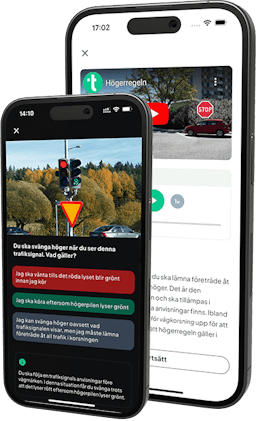Pedestrian Crossings
Uncontrolled pedestrian crossings

A pedestrian crossing is uncontrolled if it does not have any traffic lights or if there is no police officer giving instructions. At such crossings, it is important to consider the following:
- Adjust your speed: You must always adjust your speed when approaching an uncontrolled pedestrian crossing. If there are a lot of pedestrians in the area around the pedestrian crossing, then you must be extra cautious and reduce your speed.
- Duty to give way: You have a duty to give way to pedestrians who are crossing or about to cross the pedestrian crossing. If a pedestrian stands and waits for you to pass, you should reduce your speed in good time in order to show that you intend to stop and thereby avoid misunderstandings.
- No overtaking: It is prohibited to overtake a vehicle just before an uncontrolled pedestrian crossing!
- Eye contact: Seeking eye contact with pedestrians makes it easier to understand each other’s intentions and avoid misunderstandings.
- Do not wave: If a pedestrian is standing and waiting for you to drive past the pedestrian crossing, you should refrain from using your hand to wave them across. This can create a sense of security and there is a risk that the pedestrian will forget to check for other passing vehicles.
Controlled pedestrian crossings

A pedestrian crossing is controlled if it has traffic lights or if there is a police officer there giving instructions.
At controlled pedestrian crossings, you have a duty to give way to pedestrians who are crossing the carriageway at a green light. Even if the light is green for you, you must wait until all crossing pedestrians have passed before driving. Keep in mind that disabled and older people may need more time to get across the pedestrian crossing!
If you are passing a controlled pedestrian crossing while turning, be sure to reduce your speed and give way to pedestrians who have walked onto the carriageway at a green light.
Pedestrian streets and home zones
General rules for pedestrian streets and home zones:
You are not permitted to drive at a faster speed than walking pace.
You are not allowed to park. Exception: If any designated parking spaces have been marked out then you may park in these.
You must give way to pedestrians.
Generally you are only allowed to cross pedestrian streets, not drive along them. You may only drive along a pedestrian street if you are transporting goods or disabled passengers to and from a property on the street, for example. You can also use pedestrian streets to deliver goods to a shop or to transport guests to and from hotels located on the street.
Bicycle Crossings, Bicycle Passages and Bike Paths
Bicycle crossings
Bicycle crossings are marked out by road signs and road markings. Motorists have a duty to give way to cyclists and class II mopeds at these crossings.

Bicycle passages
When approaching a bicycle passage, you must adjust your speed in order to avoid a dangerous situation from arising between you and cyclists on the bicycle passage. Cyclists have a duty to give way to motorists.
If you are crossing a bicycle passage while turning or after exiting a roundabout, you must give way to cyclists and mopeds.
Bike paths
Bike paths can be used by cyclists and class II mopeds. Class I mopeds should use the carriageway. There is not always a bike path for cyclists at the side of each road; it is therefore important to keep a good safety distance at the side, in case a cyclist loses their balance and becomes unsteady, for example.
When crossing a bike path, you have a duty to give way to road users on the bike path!
If a bike path comes to an end and does not become a bicycle crossing, then cyclists and mopeds have a duty to give way to vehicles on the carriageway.

Bicycle street
On bicycle streets, the maximum permitted speed is 30 km/h, and you may only park in specially arranged parking spaces. When you drive onto a bicycle street, you have a duty to give way to vehicles on the bicycle street, and you must adapt your speed to the bicycle traffic. Bicycle streets were introduced on the 1st of December 2020.



